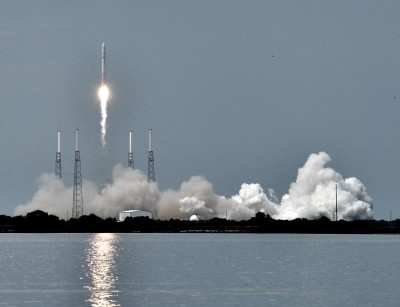COTS 2/3 Mission Announced At Annual Satellite Conference
SpaceX Company President Gwynne Shotwell used the Satellite 2012 Conference to announce that it has a thin launch window on April 30 that would get it to a scheduled May 3 berthing slot at the International Space Station. The mission, known as COTS 2/3, carries a political payload far larger than the food and clean underwear inside the spacecraft.

For Congress and the Administration, the launch might help make the case that the company's Dragon spacecraft is a viable option for ferrying astronauts to the Station some day. Moreover, it might prove that the six-year-old COTS program, which allows NASA to partner with corporations to gain access to low Earth orbit, can actually transition to a backbone for manned and unmanned spaceflight.
The upcoming flight is a maneuvering and docking test, but some time this year (probably after the November elections) Congress will vote on the 2013 NASA budget. This will include funding for CCiCap (the successor acronym to CCDev), NASA's commercial partnership for manned low Earth orbit flights. When that time comes, one or two successful private cargo flights would strengthen the case for human crews flying on domestic commercial rockets. It would also make a better case for justifying the full $850 million NASA budget request for Commercial Crew.
SpaceX also hopes to continue to prove it can carry out a possible $3.2 billion in space station resupply flights. The company has twelve resupply flights on its launch manifest, the first scheduled tentatively for July of this year. Counting the first COTS mission and three DragonLab missions, that's 16 SpaceX/unmanned Dragon spacecraft flights currently scheduled from now through 2015.

Because SpaceX is further along in its Commercial Crew program development, they are able to hit milestones like "first docking maneuver by a privately developed spacecraft". It may have company later this year, as Orbital Sciences hopes to launch its Antares rocket and unmanned Cygnus cargo spacecraft for the first time.
Space Station resupply and crew delivery are currently carried out by Russian, European, and Japanese spacecraft. Although the Russian Soyuz rocket that does the majority of ISS support is famously reliable, a August 2011 launch failure disrupted crew rotations and created concern that Station might need to be evacuated. The problem was isolated and a new crew was delivered in December. A Progress cargo resupply mission followed in January to the Station.
All of the current resupply vehicles are expendable, designed to burn themselves up in the atmosphere. The upcoming Orbital Sciences Cygnus spacecraft is expendable as well. A major departure in the Dragon spacecraft is that it's reusable, making it possible for SpaceX to charge NASA $133 million per delivery—far less than, say, the $300 million it costs just to build a European ATV cargo craft. An ATV will launch next week to resupply the station, but it is only the third to fit in the budget in five years.
Despite the reliability, the ISS' reliance on Russian (and other non-domestic) missions has created a great deal of friction in Congress centered around a loss of American ability to send humans to space. Another issue that may crop up is that NASA needs a waiver to the Iran, North Korea, and Syria Nonproliferation Act, which would otherwise bar the agency from buying goods and services from Russia. That waiver expires in 2016.
As was the case with previous flights, SpaceX is trying to minimize the anticipation. Garrett Reisman, a former astronaut also with SpaceX, told last month’s FAA Commercial Space Transportation Conference "We’re going to launch when we’re ready, and when the vehicle is ready, because we want very much for this mission to be a success."
 ANN's Daily Aero-Linx (04.15.24)
ANN's Daily Aero-Linx (04.15.24) Classic Aero-TV: 'No Other Options' -- The Israeli Air Force's Danny Shapira
Classic Aero-TV: 'No Other Options' -- The Israeli Air Force's Danny Shapira Aero-News: Quote of the Day (04.15.24)
Aero-News: Quote of the Day (04.15.24) Airborne 04.16.24: RV Update, Affordable Flying Expo, Diamond Lil
Airborne 04.16.24: RV Update, Affordable Flying Expo, Diamond Lil ANN's Daily Aero-Term (04.16.24): Chart Supplement US
ANN's Daily Aero-Term (04.16.24): Chart Supplement US




